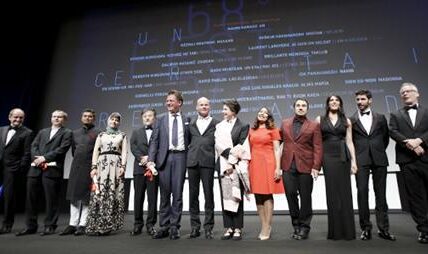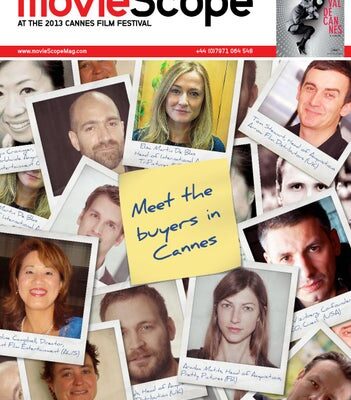You’ve made your career as a post-production supervisor on a diverse range of films; what inspired you to make this documentary?
I’ve been post supervising movies for the past 14 years, and have also been making documentaries and short films during this time. I’ve worked with some amazing folks on both the creative and technological side of things, and I’ve had a chance to see the technology of filmmaking change first-hand over these years. We really are at a moment of great change in the industry and I felt it was something worthy of documentation.
How did Keanu Reeves get involved in the project?
Side By Side would not have happened at all without Keanu. He and I were working on a movie called Henry’s Crime; Keanu was the producer and lead actor and I was the post production supervisor. A lot of the discussions and questions that you see in Side By Side came out of discussions Keanu and I were having while working together; he was really curious and fascinated by the change that was taking place in the industry. He had seen a doc that I had made a few years ago called Crazy Legs Conti: Zen and the Art of Competitive Eating, and he asked if I’d like to work with him on a film about the impact of digital technology on moviemaking. I said, ‘Absolutely when do we start!’
There are many incredible people involved in the documentary; why is the film vs digital debate sparking such passion?
Digital technology is replacing a way of making movies that has been around for over 100 years. It’s amazing to think that the basic mechanics of filmmaking haven’t changed much; you can take a piece of four-perf 35mm film from 1900 and play it in a current film projector. So a lot of people have decades of experience working with film, and have become experts in this craft. Businesses and workflows have been built around film technology and now all that is changing. This is having a huge impact on a lot of people and businesses and I think people are really excited to share their opinions on what this means.
Was it important to get a really wide range of filmmakers involved?
Keanu and I wanted to tackle this topic from a lot of different angles, and felt it was important to get interviews and opinions from a wide variety of people involved. We interviewed some top directors and cinematographers, but also took time to interview the technicians at the lab, scientists, editors, actors and others who are affected by this change. Everyone was really honest and free with their opinions and stood by them.
Were there lots of interviews that didn’t make the doc? And, if so, do you plan to make any of them available?
Yes. We interviewed over 140 people and about 70 made it into the final cut. Also, each interview we did was about 40 to 60 minutes long, so we have a lot of material! We are trying to figure out a way to make all the interviews available as a resource for those interested in delving in a little deeper. There is talk of a series of books and, of course, video, and you can see some outtakes on the Tribeca Film website. We did a whole series of really interesting short clips that didn’t make it into the movie. (www.tribecafilm.com/videos/?sortBy=-startDate&11963=1030576)
What was the consensus among the people you interviewed about the future of filmmaking?
Most people realize that digital technology is growing and has improved a great deal since its early days. There are still a huge number of film lovers and hopefully those people will continue to have the choice of using film for as long as they want, but I think most people believed that digital is the direction that movie making is headed.
And did anything surprising emerge during the course of filming the documentary?
I thought that the people who had been working with film for decades and had the most experience with film might be more resistant to the new digital technology and I thought that the younger generation wouldn’t really care about film. But it didn’t actually break down that way. It wasn’t a generational thing. There were older DPs who were so excited about digital and younger folks who were really film lovers. So it had more to do with individual personalities and preferences than age or anything else.
I think viewers will be surprised and a little bit scared when they watch the section on ‘Archival’. There are definitely issues with digital storage and obsolescence that still need to be solved. Many experts believe that film is the safest way to store moving images.
A lot of time is spent with James Cameron, who really is a pioneer of new filmmaking technology. What do you think drives him?
There are certain people who are always pushing things forward and developing new tools and new ways to make images and tell stories. Cameron has always been one of those people. Even when he was shooting film he was using digital technology for visual effects, and many of the milestones in the VFX industry were Cameron creations. He also pushed the virtual camera and 3D technology to a new level with Avatar. I think it is storytelling that drives him; I don’t feel that he is using technology just for a gimmick, but rather to elevate his story and express his ideas better.
What are your personal feelings on 3D?
I don’t love 3D right now. There are moments when it is great, but there are many times during 3D movies that I’m not enjoying it. I think it will get better and better. The technology and the craft will improve, and I think we are going to see some amazing 3D over the next few years.
In the film, there are are interesting comparisons drawn between the Dogme generation and today’s low-budget filmmakers; do you think such grassroots filmmakers play an important role in the industry?
Digital technology is such a great tool for independent moviemakers. The cameras that are available today can give you an amazing image for a low cost. You can shoot with small crews. Editing and post production, even distribution is in the hands of almost anyone. I think having independence and freedom is a huge advantage for artists. Hopefully new types of movies and original works will be created because of this freedom. Independent filmmakers have always embraced new technology and have used it in unique ways; it’s really interesting to see how the science and art push and inspire each other.
Why isn’t the same merit given to today’s low-budget filmmakers as their Dogme equivalents? Is it because technology has lowered the bar in terms of skill and quality?
I’m not sure I agree with the premise of the question. There are some great independent, low-budget movies being made today. There are great series on the web that are really pushing the art form forward. The technology has made it easier and there is a lot more material out there today. That means that there are more bad movies out there, but there are also more great movies being made. It takes a little effort by the viewer to sift through this all and find what they consider good, but to me that is a small price to pay.
Side by Side took a year to make, from November 2010 to December 2011. Did anything change in the film vs digital debate during that time?
Things were changing constantly as we were making this doc. Kodak declared bankruptcy, all major film camera manufacturers stopped making film cameras, exhibition grew to over 50 per cent digital in the USA, the Alexa camera was just coming out and the Red Epic came out… so we were right in this moment of change. I think we set out to make this doc just at the right time.
And have things changed even more since you finished making the film?
Technology is constantly changing. Fuji has now stopped making film; new digital cameras are coming out’ more theatres are forced to convert to digital projection; more movies are now digital all the way from capture to exhibition. And this is happening worldwide.
What do you hope the film will achieve; spark more debate, raise awareness, etc.?
I remember when we were editing and watching back the section where we see the clip of Collateral and [colourist] Stefan Sonnenfeld and [cinematographer] Dion Beebe talk about the colours of the night sky in Los Angeles, and how they achieved that look. It really helped me see these images and that movie in a different way. I hope Side By Side will give people something to think about, and will make people enjoy movies on another level. My hope would be that the doc excites people about cinema and inspires them to watch some great movies—whether shot on film or digital.
Finally, you shot Side by Side on digital; what are your personal feelings about digital filmmaking, and the place of 35mm moving forward?
We had a low budget, a small crew, a short amount of time to set up and we travelled a great deal so digital cameras just made sense for this project. Personally, I love film. Everything that I grew up watching and everything that inspired me to make movies was shot on film. I think that digital technology is going to take over. Film will still be a choice for a certain level of directors and DPs. It’s sad to say, but I think the newer generation is not going to have a choice and film will soon be replaced.•










